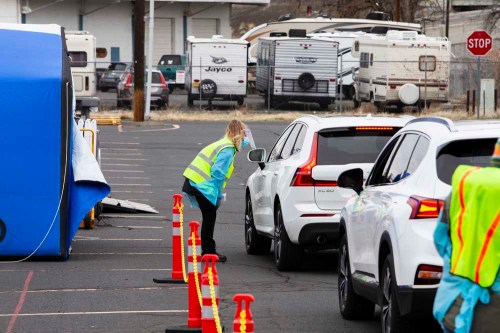Oregon COVID-19 trends slowing, Eastern Oregon shows mixed results
Published 1:30 pm Tuesday, May 11, 2021

- COVID-19 testing clinic staff instruct drivers on testing procedures during a drive-thru COVID-19 testing event at the Pendleton Convention Center on Feb. 8, 2021.
SALEM — Eastern Oregon showed a mixed set of results under the latest weekly COVID-19 risk level numbers released by the Oregon Health Authority on Monday, May 10.
Because of the wide difference in population, a smaller county’s numbers can often show wide swings based on smaller samples. The state has often put counties in lower levels than the statistics might indicate because of underlying information.
Umatilla County — categorized as a large county — dropped nearly 10 points to 136.2 cases per 100,000, a rate that would rank it as moderate risk. The only downside was an uptick in the percent of positive cases to 5.5% in the new reporting period, up from 5% reported last week.
Baker County’s statistics were trending down but remained high compared to other areas in the state. The county showed a decline in cases to 47 and a drop in cases per 100,000 to 277.9 from 360.7 in the previous report. The positive infection rate is 9%, down from 10.6% in the last report.
Union County held the line for the most part on cases. It showed a small uptick in positive test rates, to 2.7% from 2%, but its case numbers were almost identical to the last reporting period.
Cases and rates are up in Wallowa and Gilliam counties, but the small population leaves their risk level status to be announced Tuesday, May 11, more up in the air than other counties in the region.
Grant County, a hot spot in recent weeks, showed an overall decline in cases, but reported positive cases were up to 10% — twice the level that OHA says is needed to keep cases from rebounding sharply.
The official announcement on any changes in risk levels — and restrictions in each county — will not be announced by Gov. Kate Brown until May 11.
But some of the numbers showed clear indicators of what to expect.
Overall, they show a slight decline in COVID-19 cases over the past two weeks, compared to last week’s report.
The state reported 10,755 new cases over the two-week period, which equals 252 cases per 100,000 residents. Both are slight declines over the previous period.
The rate of positive cases remains at 6.4% — state officials say anything above 5% has the potential to lead to a rebound of cases.
Several counties had case rates that would in the past have pushed them into the extreme risk category. For large counties, an infection rate of more than 200 per 100,000 people would place them in the most restrictive of the state’s four risk level tiers.
But Brown introduced a new metric last month that keeps counties from the harshest limits, including a ban on indoor dining.
Counties will not be put in the extreme risk level regardless of their own COVID-19 numbers if the state overall has under 300 hospitalizations for COVID-19. After that threshold is crossed, an increase of 15% has to be met to hit the extreme risk level.
As of May 10, the Oregon Health Authority reported 324 confirmed COVID-19 hospitalizations in the state, a slight reduction over the last period.
Under the rules, those numbers mean no counties will be put in extreme risk level when the new limits are announced May 11 and go into effect Friday, May 14.
The new numbers show Central Oregon has among the highest levels of infection and rates. Deschutes, Crook and Jefferson counties are well above the 200 infections per 100,000 mark. But because of the statewide metric requirement, they will almost certainly stay in the high risk limit level, the second more restrictive of the state’s four tiers.
Deschutes County reported 1,069 COVID-19 cases over the past two weeks, with the cases per 10,000 rising to 542.6. Also up is the positive test rate, which at 9% is seen by health officials as a figure that could lead to future exponential growth of cases.
Crook County reported 546 cases per 100,000, a slight increase. But its test positivity rate fell to 8.6% from 9%. While still high, the rate is trending in the right direction.
Jefferson County also saw its rate per 100,000 rise to 315.3 cases per 100,000, but its positive test rate fell to 8.5% from 8.9%.









